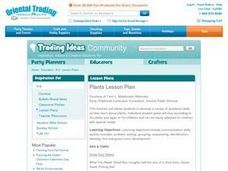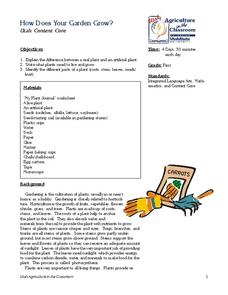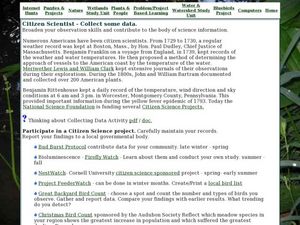Curated OER
Plant Science Activities
Learners complete several plant life activities. In this botany lesson, students practice painting images that resemble plants they are familiar with as well as planting seeds outside of class. Learners participate in a dramatic...
Curated OER
Insects Around Us
Students fill out worksheets about insects and how they are helpful to our world. In this insects lesson plan, students learn about flower parts and insects that pollinate them.
Curated OER
Heredity Worksheet #2
In this genetics worksheet, students use a diagram showing the genetic offspring of plants with different types of seeds to answer 4 short answer questions. Then students determine the traits of offspring of different crosses in 1...
Curated OER
Pollination Station
Students investigate why and how bees pollinate flowers and other plants. They define pollination, and read and sing along with the song "Yo, i'm a Flower." Students examine a diagram of a flower, simulate bees pollinating flowers, and...
Curated OER
Plants-Missing Letters Spelling Activity
In this plant spelling worksheet, learners are given definitions of words related to plants and fill in the missing letters to finish the matching word. A reference web site is given for additional activities.
Curated OER
Native Beauty
Young scholars plant wild flowers and maintain their garden. In this wild flowers lesson plan, students pick and prepare a gardening site, plant wild flowers, and maintain it everyday.
Curated OER
Responses to Changes in the Environment
Fourth graders study ecosystems, and see how plants and animals must adapt to changes in their environment in order to survive. Pictures of the snow shoe hare in the winter and summer are shown. Learners determine that the change in...
Alabama Learning Exchange
Nature's Life Cycle
Become a member of the Pollution Patrol and stand up to litter! After discussing the life cycle of seeds and discussing how plants figure into the food chain, young conservationists engage in several activities involving podcasts,...
Curated OER
Asexual Propagation
Grow plants from the ones you already have. Explore plant-cutting techniques through this detailed guide covering herbaceous, soft-wood, and semi-hardwood species. Ideal to use with a higher-ed or vocational class. Tip: Invite students...
Curated OER
Evolution of Plants
This is a wonderful PowerPoint! It gives excellent details of different types of ferns and their characteristics which help them to survive and produce spores in many varied habitats.
Academy of American Poets
Teach This Poem: "The Tradition" by Jericho Brown
To begin this lesson plan, class members examine Antonius Hockelmann's painting "Tree Flowers II," record elements of the painting that they notice, and share their observations with a partner. Next, pupils do a close reading of Jericho...
Curated OER
Plants
Second graders examine the characteristics of plants. As a class, they brainstorm a list of items plants need in order to survive. In groups, they complete various experiments in which they discover the functions of the parts of the plant.
Curated OER
Understanding the Roots
Young scholars investigate the parts of a flower. For this earth science lesson, students read the book The Magic School Bus Plants Seeds and identify various plant parts. Young scholars construct a model of a flowering plant from...
Curated OER
Life Cycles
Students explore the parts of a flower and pollination of flowers. In this plants lesson, students use an interactive whiteboard to label the parts of a plant and the functions of each part. Students complete a worksheet as an assessment.
Curated OER
What Bees Eat
Students consider the concept that plants and animals are dependent on one another and role-play the interaction between bees and flowers. They identify crops that are dependent on pollination by bees.
Curated OER
PLANT PARTS WE EAT
Students identify an assortment of vegetables and learn how to locate the parts humans use for food. Students identify the plant parts we eat. Students color the pictures on their worksheets as provided. Students match the plants to the...
Curated OER
Body Language
First graders investigate the three main parts of a plant. In this plant parts lesson, 1st graders explore vocabulary for the topic and read a story about plant parts. Students view a PowerPoint and take a quiz for the topic....
Curated OER
Berenstain Bears: Grow It
Second graders read several books and complete an activity that coincides with each book. i.e. They read 'Berenstain Bears: Grow It' by Stan and Jan Berenstain and then decorate a flower pot, plant flower seeds in it and record their...
Curated OER
Parts of a Plant
Students explore biology by listening to an in-class lecture. In this plant science lesson, students sing songs with their classmates regarding anatomical parts of a plant and create plants from arts and crafts materials. Students listen...
Curated OER
Plant Dissection
Students study plant parts and their functions in a dissection activity. In this plant dissection instructional activity, students use several handouts to help them learn parts of the plant and their functions. Students then dissect...
Curated OER
Pollination
Students investigate pollination. In this plant biology lesson, students study a diagram of the reproductive parts of the flower and dissect and identify the parts of a real flower.
Curated OER
How Does Your Garden Grow?
Pupils identify what plants need to grow. In this plant biology lesson plan, students analyze the differences between an artificial plant and a live plant. Pupils plant seeds and discuss what plants need to grow. Students observe the...
Curated OER
Citizen Scientist - Collect Some Data
In this science project activity, students view a sheet of numerous science projects including weather, animals, flowers, and more. Students choose 1 project to do out of 22 projects total.
Curated OER
Biodiversity Exploration
In this biodiversity worksheet, students click on the links in the questions about plants, leaves, and flowers to find the answers to the questions and then come back and answer the questions. Students answer 11 questions total.























